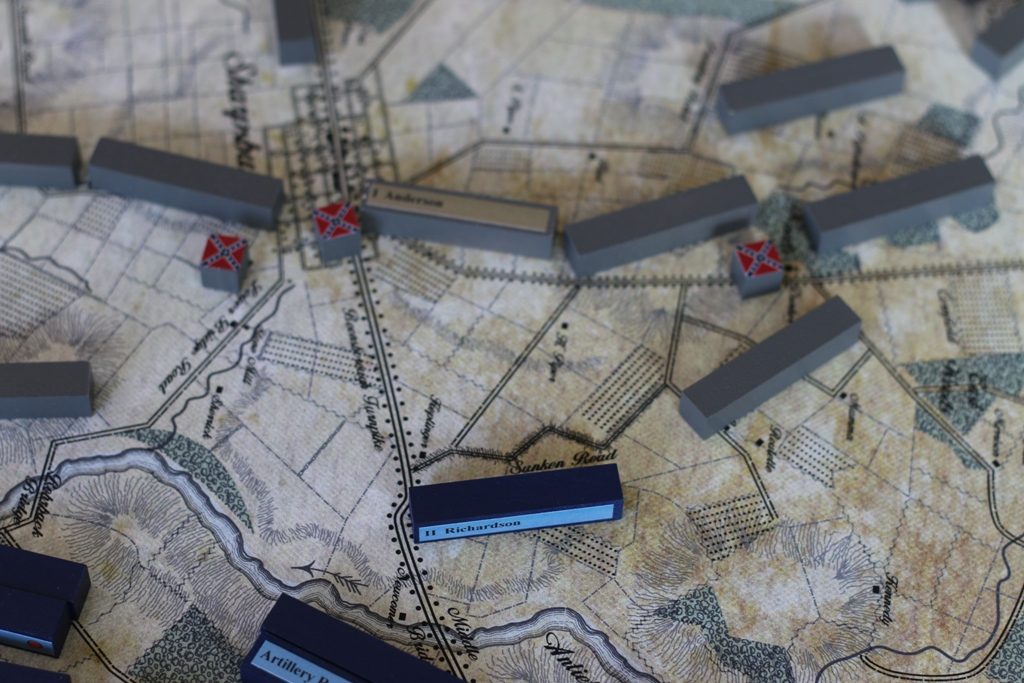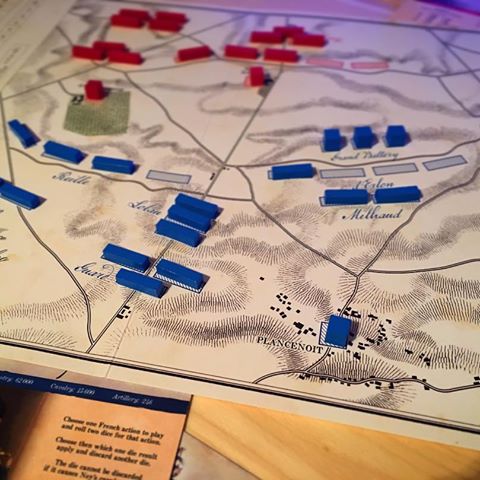How does a large army with many small Corps differ from a small army with a few large Corps? Antietam is a great example of this. The Federal Army of the Potomac had 6-7 small Corps. The Confederate Army of Northern Virginia had only 2 Corps but they were large. What impact do these different command structures have?

Many of these differences become clear in the Pub Battles system. Each Corps has a chit. The Corps move in random order as you pull these chits from a cup. HQs can attempt to alter this random sequence by rolling a die. You can attempt to move first by jumping ahead of the current pull, OR delay your move by returning your chit to the cup.
The Federals must roll 1-3 to be successful. The Confederates are more likely to pull off the timing they want as they only need 1-4. This isn’t to say that all the Confederate officers were better. It is more a reflection of the command structure. The Potomac had more Corps and more command layers. It stands to reason that it would take a little longer for their orders to actually get people moving.
Ok, so how does all this actually impact game play? Who has the advantage? The big army with lots of Corps or the small army with few, large Corps? Here is a quick analysis:
Case 1
Big army wants to attack little army all up and down the line. They can’t just advance everybody at once to engage. They can only advance 1 small Corps at a time. This will leave openings and gaps in the line. The little army should be able to move in between these moves and cause all kinds of chaos and awkwardness. It is easy to catch them with 1 foot over the barrel.
Advantage: Small Army
Case 2
Little army wants to attack big army all up and down the line. With a little luck and timing, they most likely can pull off a coordinated attack all up and down the line at once.
Advantage: Small Army
Case 3
Traffic jams! You are trying to relocate a big portion of your army. This can easily result in traffic jams for the Big Army. If you can’t pull in the right sequence, several Corps will be held up waiting for the ones in front of them to move. This tends to make Big Armies slow and lethargic. Sounds a lot like McClellan doesn’t it?
Advantage: Small Army
Case 4
Let’s say it’s time to bug out. All hell is breaking loose and you just want to flee. This is like the big coordinated attack all at once, only in reverse. If you can’t move in the right sequence, some Corps will get stuck. Others will be in the way. Which ones are fighting a rear guard action? This can become a huge nightmare. Especially if the Small Army can very likely jump in and strike at the worst possible moment.
Advantage: Small Army
Case 5
The Big Army does have more flexibility and a slight advantage in numbers. Antietam is a good example. Let’s say the Federal artillery bombards a Confederate Division in the Sunken Road. The Confederates flip and run. Now who moves next? This is critical. The Federals have more chits in the cup. So they have better chances of getting pulled first to occupy the Sunken Road before the Confederates can.
There is also a good chance that the Confederates already moved for the turn. Their whole army is concentrated in 2 Corps. What if they got picked early in the turn? They delayed but then got picked again? That is half their army that has to move early. Good chance they won’t be able to scramble back into the Sunken Road now.
The Federals have 6-7 Corps. Much better chances at getting one of them picked to move first. This seems like a huge advantage but not so fast. First, consider that most of those Corps can’t actually get to the Sunken Road. They are scattered around the field. Maybe only 2 or 3 of them can actually get there. Also, remember that some of those 2-3 Corps may have already moved.
Advantage: Slight advantage to Big Army. Not as big as you might think.

So at Antietam, these 2 armies are going feel very different. They will require a completely different approach and strategy. There are going to be many other things to consider in your moves. I like how none of this requires any new rules. It is already built into the system.
It is going to require a little more thought, a little more time. It is more complex but the complexity is in strategy, planning and decisions, NOT in learning and remembering more rules. I like complexity in command decisions. This is complexity well spent on a game design. Not complexity in how units technically move and fight. Not in looking up results on tables of data.
This complexity is spent pondering timing effects related to command and how that can impact battle results. These are decisions related to command.
This is what we are all about.










